Zoekresultaten voor "home OR automation OR projects OR with OR arduino"
-

Elektor Digital Home Automation Projects with Arduino (E-book)
Using the RFID Starter Kit An Arduino board has now become ‘the’ basic component in the maker community. No longer is an introduction to the world of microcontrollers the preserve of the expert. When it comes to expanding the capabilities of the basic Arduino board however, the developer is still largely on his own. If you really want to build some innovative projects it’s often necessary to get down to component level. This can present many beginners with major problems. That is exactly where this book begins. This book explains how a wide variety of practical projects can be built using items supplied in a single kit together with the Arduino board. This kit, called the 'RFID Starter Kit for Arduino' (SKU 17240) is not just limited to RFID applications but contains more than 30 components, devices and modules covering all areas of modern electronics. In addition to more simple components such as LEDs and resistors there are also complex and sophisticated modules that employ the latest technology such as: A humidity sensor A multicolor LED A large LED matrix with 64 points of light A 4-character 7-segment LED display An infra red remote-controller unit A complete LC-display module A servo A stepper motor and controller module A complete RFID reader module and security tag On top of that you will get to build precise digital thermometers, hygrometers, exposure meters and various alarm systems. There are also practical devices and applications such as a fully automatic rain sensor, a sound-controlled remote control system, a multifunctional weather station and so much more. All of the projects described can be built using the components supplied in the Elektor kit.
€ 29,95
Leden € 23,96
-

Elektor Publishing Controller Area Network Projects with ARM and Arduino
This book details the use of the ARM Cortex-M family of processors and the Arduino Uno in practical CAN bus based projects. Inside, it gives a detailed introduction to the architecture of the Cortex-M family whilst providing examples of popular hardware and software development kits. Using these kits helps to simplify the embedded design cycle considerably and makes it easier to develop, debug, and test a CAN bus based project. The architecture of the highly popular ARM Cortex-M processor STM32F407VGT6 is described at a high level by considering its various modules. In addition, the use of the mikroC Pro for ARM and Arduino Uno CAN bus library of functions are described in detail. This book is written for students, for practising engineers, for hobbyists, and for everyone else who may need to learn more about the CAN bus and its applications. The book assumes that the reader has some knowledge of basic electronics. Knowledge of the C programming language will be useful in later chapters of the book, and familiarity with at least one microcontroller will be an advantage, especially if the reader intends to develop microcontroller based projects using CAN bus. The book should be useful source of reference to anyone interested in finding an answer to one or more of the following questions: What bus systems are available for the automotive industry? What are the principles of the CAN bus? What types of frames (or data packets) are available in a CAN bus system? How can errors be detected in a CAN bus system and how reliable is a CAN bus system? What types of CAN bus controllers are there? What are the advantages of the ARM Cortex-M microcontrollers? How can one create a CAN bus project using an ARM microcontroller? How can one create a CAN bus project using an Arduino microcontroller? How can one monitor data on the CAN bus?
€ 44,95
Leden € 40,46
-
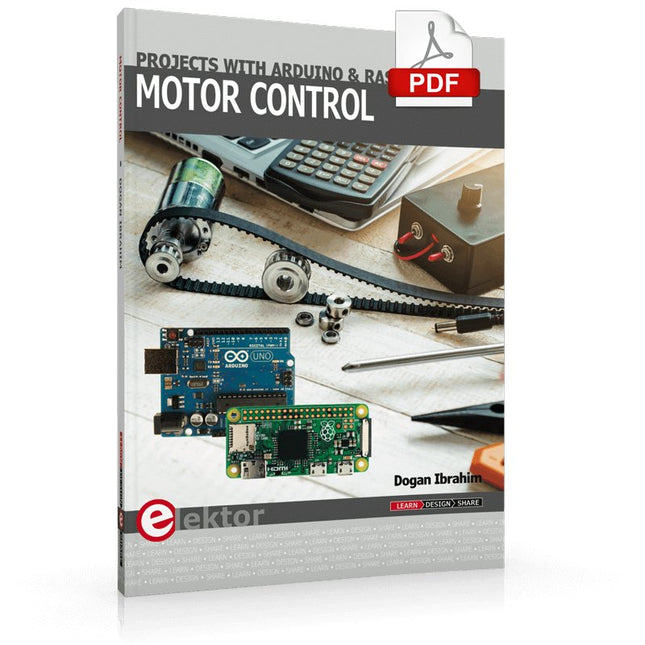
Elektor Digital Motor Control - Projects with Arduino & Raspberry Pi (E-book)
This book is about DC electric motors and their use in Arduino and Raspberry Pi Zero W based projects. The book includes many tested and working projects where each project has the following sub-headings: Title of the project Description of the project Block diagram Circuit diagram Project assembly Complete program listing of the project Full description of the program The projects in the book cover the standard DC motors, stepper motors, servo motors, and mobile robots. The book is aimed at students, hobbyists, and anyone else interested in developing microcontroller based projects using the Arduino Uno or the Raspberry Pi Zero W. One of the nice features of this book is that it gives complete projects for remote control of a mobile robot from a mobile phone, using the Arduino Uno as well as the Raspberry Pi Zero W development boards. These projects are developed using Wi-Fi as well as the Bluetooth connectivity with the mobile phone. Readers should be able to move a robot forward, reverse, turn left, or turn right by sending simple commands from a mobile phone. Full program listings of all the projects as well as the detailed program descriptions are given in the book. Users should be able to use the projects as they are presented, or modify them to suit to their own needs.
€ 29,95
Leden € 23,96
-
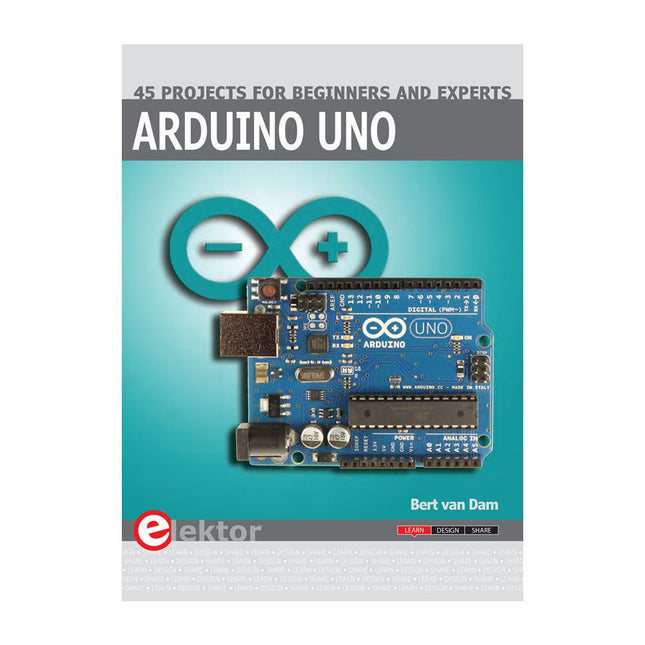
Elektor Publishing Arduino Uno – 45 Projects for Beginners and Experts
This book covers a series of exciting and fun projects for the Arduino, such as a silent alarm, people sensor, light sensor, motor control, internet and wireless control (using a radio link). Contrary to many free projects on the internet all projects in this book have been extensively tested and are guaranteed to work! You can use it as a projects book and build more than 45 projects for your own use. The clear explanations, schematics, and pictures of each project make this a fun activity. The pictures are taken of a working project, so you know for sure that they are correct. You can combine the projects in this book to make your own projects. To facilitate this, clear explanations are provided on how the project works and why it has been designed the way it has That way you will learn a lot about the project and the parts used, knowledge that you can use in your own projects. Apart from that, the book can be used as a reference guide. Using the index, you can easily locate projects that serve as examples for the C++ commands and Arduino functionality. Even after you’ve built all the projects in this book, it will still be a valuable reference guide to keep next to your PC.
€ 39,95
Leden € 35,96
-

Elektor Digital Home Automation and Electronics for Starters (E-book)
Projecten met Arduino, ESPHome, Home Assistant en Raspberry Pi & Co. Dit e-book bevat verschillende voorbeeldprojecten, te beginnen met een inleiding tot elektronica. Het legt ook uit hoe je Home Assistant installeert op een Raspberry Pi, hoe je binnenklimaatsensoren gebruikt voor temperatuur en vochtigheid, hoe je het MQTT-protocol en andere interfaces implementeert, en hoe je ESPHome gebruikt om sensoren en actuatoren te integreren in Home Assistant. Talrijke video tutorials vullen het boek aan. The book begins with an introduction to electrical engineering. You will learn the basics of voltage, current, resistors, diodes and transistors. Arduino and microcontrollers A complete section is dedicated to the Arduino Uno. You will get to know the structure, write your first programs and work on practical examples. Home Assistant and automation You will learn how to set up Home Assistant on a Raspberry Pi and how to use automations, scenes and devices. In addition, Zigbee, MQTT and ESP-NOW – important technologies for home automation – will be discussed. ESP8266, ESP32 and ESP32-CAM The popular ESP microcontrollers are covered in detail. A theoretical introduction is followed by practical projects that show you how to get the most out of these devices. Sensors and actuators The book explains the functionality and application of numerous sensors such as temperature and humidity sensors, motion detectors and RFID readers. For actuators, stepper motors, e-ink displays, servo motors and much more are covered. There are practical application examples for all devices. ESPHome This chapter shows you how to integrate sensors and actuators into Home Assistant without any programming effort. You will be guided step by step through the setup with ESPHome. LEDs and lighting technology In this chapter, you will learn about different types of LEDs and how they can be used. The basics of lighting technology are also explained. Node-RED A whole chapter is dedicated to Node-RED. You will learn the basics of this powerful tool and be guided step by step through its setup and use. Integrated Circuits (ICs) In electronics, there are numerous ICs that make our lives easier. You will get to know the most important ones and apply your knowledge in practical projects. Professional programming Advanced topics such as the correct use of buttons, the use of interrupts and the use of an NTP server for time synchronisation are covered in detail in this chapter. Downloads GitHub
€ 49,95
Leden € 44,96
-

Elektor Digital Arduino – Circuits & Projects Guide (E-book)
Two reasons can be identified for the immense success of the Arduino platform. First, the cheap, ready to go processor board greatly simplifies the introduction to hardware. The second success factor is the free and open-source programming suite that does not require an installation procedure. Simple entry-level examples ensure rapid successes. Complex selection procedures for parameters like the microprocessor version or interface settings are not required. The first sample programs can be uploaded to the Arduino board, and tested, in a matter of minutes. The Arduino user is supported by an array of software libraries. However, the daily increasing volume of libraries poses initial problems to the newcomer, and the way ahead may be uncertain after a few entry-level examples. In many cases, detailed descriptions are missing, and poorly described projects tend to confuse rather than elucidate. Clear guidance and a single motto are missing, usually owing to the projects having been created by several different persons—all with different aims in mind. This book represents a different approach. All projects are presented in a systematical manner, guiding into various theme areas. In the coverage of must-know theory great attention is given to practical directions users can absorb, including essential programming techniques like A/D conversion, timers and interrupts—all contained in the hands-on projects. In this way readers of the book create running lights, a wakeup light, fully functional voltmeters, precision digital thermometers, clocks of many varieties, reaction speed meters, or mouse controlled robotic arms. While actively working on these projects the reader gets to truly comprehend and master the basics of the underlying controller technology.
€ 29,95
Leden € 23,96
-
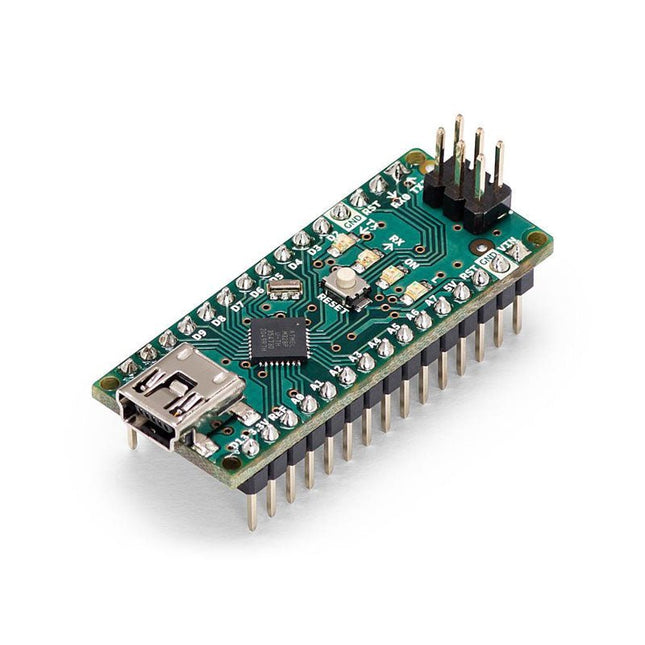
Arduino Arduino Nano
De Arduino Nano is een klein, compleet en breadboard-vriendelijk bordje gebaseerd op de ATmega328 (Arduino Nano 3.x). Het heeft min of meer dezelfde functionaliteit als de Arduino Duemilanove, maar in een andere verpakking. Het mist alleen een DC voedingsaansluiting en werkt met een Mini-B USB-kabel in plaats van een standaard kabel. Specificaties Microcontroller ATmega328 Bedrijfsspanning (logisch niveau) 5 V Ingangsspanning (aanbevolen) 7-12 V Inputspanning (limieten) 6-20 V Digitale I/O-pinnen 14 (waarvan 6 met PWM-uitgang) Analoge ingangspinnen 8 DC-Stroom per I/O-Pin 40 mA Flashgeheugen 16 KB (ATmega168) of 32 KB (ATmega328) waarvan 2 KB gebruikt door bootloader SRAM 1 KB (ATmega168) of 2 KB (ATmega328) EEPROM 512 bytes (ATmega168) of 1 KB (ATmega328) Kloksnelheid 16 MHz Afmetingen 18 x 45 mm Voeding De Arduino Nano kan via de Mini-B USB-verbinding, 6-20 V ongeregelde externe voeding (speld 30), of 5 V geregelde externe voeding (speld 27) worden aangedreven. De voedingsbron wordt automatisch geselecteerd op de hoogste spanningsbron. Geheugen De ATmega168 heeft 16 KB flash-geheugen voor het opslaan van code (waarvan 2 KB wordt gebruikt voor de bootloader), 1 KB SRAM en 512 bytes EEPROM De ATmega328 heeft 32 KB flash-geheugen voor de opslag van code, (waarvan ook 2 KB wordt gebruikt voor de bootloader), 2 KB SRAM en 1 KB EEPROM. Input en output Elk van de 14 digitale pinnen op de Nano kan worden gebruikt als ingang of uitgang, met behulp van pinMode(), digitalWrite(), en digitalRead() functies. Zij werken bij 5 V. Elke pin kan maximaal 40 mA leveren of ontvangen en heeft een interne pull-up weerstand (standaard uitgeschakeld) van 20-50 kOhms. Communicatie De Arduino Nano heeft een aantal faciliteiten om te communiceren met een computer, een andere Arduino, of andere microcontrollers. De ATmega168 en ATmega328 bieden UART TTL (5V) seriële communicatie, die beschikbaar is op de digitale pennen 0 (RX) en 1 (TX). Een FTDI FT232RL op de raad kanaliseert deze periodieke mededeling over USB en de FTDI drivers (inbegrepen met de Arduino-software) verstrekt een virtuele com-haven aan software op de computer. De Arduino-software omvat een seriële monitor waarmee eenvoudige tekstuele gegevens naar en van de Arduino-raad kunnen worden verzonden. De RX en TX LEDs op het bord zullen knipperen wanneer gegevens via de FTDI-chip en de USB-verbinding met de computer worden verzonden (maar niet voor seriële communicatie op pennen 0 en 1). Een SoftwareSerial bibliotheek maakt seriële communicatie op elk van de digitale pinnen van de Nano mogelijk. Programmeren De Arduino Nano kan geprogrammeerd worden met de Arduino software (download). De ATmega168 of ATmega328 op de Arduino Nano wordt geleverd met een bootloader waarmee u nieuwe code kunt uploaden zonder het gebruik van een externe hardware programmeur. Het communiceert met behulp van het originele STK500 protocol (referentie, C header files). U kunt ook de bootloader omzeilen en de microcontroller programmeren via de ICSP (In-Circuit Serial Programming) header met Arduino ISP of vergelijkbaar; zie deze instructies voor details. Automatisch (software) resetten Rather dan het vereisen van een fysieke druk van de het terugstellenknoop vóór een upload, wordt Arduino Nano ontworpen op een manier die het om door software toelaat worden teruggesteld die op een verbonden computer loopt. Eén van de hardwarestroom controlelijnen (DTR) van deFT232RL wordt verbonden met de het terugstellenlijn van de ATmega168 of ATmega328 via een 100 nF condensator. Wanneer deze lijn wordt bevestigd (laag genomen), daalt de resetlijn lang genoeg om de chip te resetten. De Arduino-software gebruikt dit vermogen om u toe te staan om code te uploaden door eenvoudig de uploadknoop in het Arduino-milieu te drukken. Dit betekent dat de bootloader een kortere time-out kan hebben, aangezien het verlagen van DTR goed gecoördineerd kan worden met het begin van de upload.
€ 22,95
Leden € 20,66
-
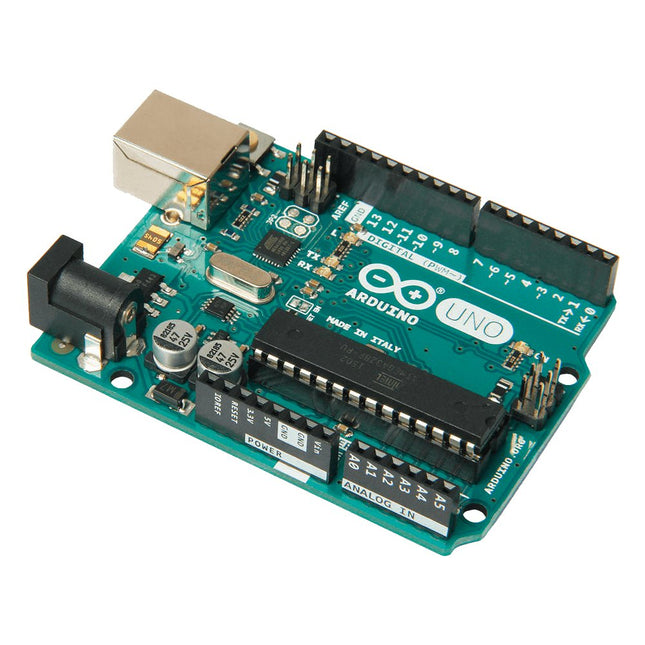
Arduino Arduino Uno Rev3
Arduino Uno is een open-source microcontroller bord gebaseerd op de ATmega328P. Het heeft 14 digitale in-/uitgangspinnen (waarvan er 6 kunnen worden gebruikt als PWM-uitgangen), 6 analoge ingangen, een 16 MHz keramische resonator (CSTCE16M0V53-R0), een USB-aansluiting, een voedingsaansluiting, een ICSP-header en een reset-knop. Het bevat alles wat nodig is om de microcontroller te ondersteunen; sluit het gewoon aan op een computer met een USB-kabel of voed het met een AC-to-DC adapter of batterij om aan de slag te gaan. Je kunt aan je Uno sleutelen zonder je al te veel zorgen te maken dat je iets verkeerd doet, in het ergste geval kun je de chip voor een paar dollar vervangen en opnieuw beginnen. 'Uno' betekent één in het Italiaans en werd gekozen om de release van Arduino Software (IDE) 1.0 te markeren. Het Uno-bord en versie 1.0 van Arduino Software (IDE) waren de referentieversies van Arduino, nu geëvolueerd naar nieuwere versies. De Uno board is de eerste in een reeks van USB Arduino boards, en het referentiemodel voor het Arduino platform; voor een uitgebreide lijst van huidige, voorbije of verouderde boards zie de Arduino index van boards. Specificaties Microcontroller ATmega328P Bedrijfsspanning 5 V Ingangsspanning (aanbevolen) 7-12 V Ingangsspanning (limiet) 6-20 V Digitale I/O-pinnen 14 (waarvan 6 met PWM-uitgang) PWM digitale I/O-pinnen 6 Analoge ingangspinnen 6 DC Stroom per I/O Pen 20 mA DC Stroom voor 3,3 V Pin 50 mA Flashgeheugen 32 KB (ATmega328P) waarvan 0,5 KB gebruikt door bootloader SRAM 2 KB (ATmega328P) EEPROM 1 KB (ATmega328P) Kloksnelheid 16 MHz LED_BUILTIN 13 Afmetingen 68,6 x 53,4 mm Gewicht 25 g
€ 24,95
Leden identiek
-

Elektor Digital Arduino Uno – 45 Projects for Beginners and Experts (E-book)
This book covers a series of exciting and fun projects for the Arduino, such as a silent alarm, people sensor, light sensor, motor control, internet and wireless control (using a radio link). Contrary to many free projects on the internet all projects in this book have been extensively tested and are guaranteed to work! You can use it as a projects book and build more than 45 projects for your own use. The clear explanations, schematics, and pictures of each project make this a fun activity. The pictures are taken of a working project, so you know for sure that they are correct. You can combine the projects in this book to make your own projects. To facilitate this, clear explanations are provided on how the project works and why it has been designed the way it has That way you will learn a lot about the project and the parts used, knowledge that you can use in your own projects. Apart from that, the book can be used as a reference guide. Using the index, you can easily locate projects that serve as examples for the C++ commands and Arduino functionality. Even after you’ve built all the projects in this book, it will still be a valuable reference guide to keep next to your PC.
€ 29,95
Leden € 23,96
-

Elektor Publishing C Programming with Arduino
Technology is constantly changing. New microcontrollers become available every year. The one thing that has stayed the same is the C programming language used to program these microcontrollers. If you would like to learn this standard language to program microcontrollers, then this book is for you! Arduino is the hardware platform used to teach the C programming language as Arduino boards are available worldwide and contain the popular AVR microcontrollers from Atmel. Atmel Studio is used as the development environment for writing C programs for AVR microcontrollers. It is a full-featured integrated development environment (IDE) that uses the GCC C software tools for AVR microcontrollers and is free to download. At a glance: Start learning to program from the very first chapter No programming experience is necessary Learn by doing – type and run the example programs A fun way to learn the C programming language Ideal for electronic hobbyists, students and engineers wanting to learn the C programming language in an embedded environment on AVR microcontrollers Use the free full-featured Atmel Studio IDE software for Windows Write C programs for 8-bit AVR microcontrollers as found on the Arduino Uno and MEGA boards Example code runs on Arduino Uno and Arduino MEGA 2560 boards and can be adapted to run on other AVR microcontrollers or boards Use the AVR Dragon programmer/debugger in conjunction with Atmel Studio to debug C programs
€ 49,95
Leden € 44,96
-

Elektor Digital Controller Area Network Projects with ARM and Arduino (E-book)
This book details the use of the ARM Cortex-M family of processors and the Arduino Uno in practical CAN bus based projects. Inside, it gives a detailed introduction to the architecture of the Cortex-M family whilst providing examples of popular hardware and software development kits. Using these kits helps to simplify the embedded design cycle considerably and makes it easier to develop, debug, and test a CAN bus based project. The architecture of the highly popular ARM Cortex-M processor STM32F407VGT6 is described at a high level by considering its various modules. In addition, the use of the mikroC Pro for ARM and Arduino Uno CAN bus library of functions are described in detail. This book is written for students, for practising engineers, for hobbyists, and for everyone else who may need to learn more about the CAN bus and its applications. The book assumes that the reader has some knowledge of basic electronics. Knowledge of the C programming language will be useful in later chapters of the book, and familiarity with at least one microcontroller will be an advantage, especially if the reader intends to develop microcontroller based projects using CAN bus. The book should be useful source of reference to anyone interested in finding an answer to one or more of the following questions: What bus systems are available for the automotive industry? What are the principles of the CAN bus? What types of frames (or data packets) are available in a CAN bus system? How can errors be detected in a CAN bus system and how reliable is a CAN bus system? What types of CAN bus controllers are there? What are the advantages of the ARM Cortex-M microcontrollers? How can one create a CAN bus project using an ARM microcontroller? How can one create a CAN bus project using an Arduino microcontroller? How can one monitor data on the CAN bus?
€ 32,95
Leden € 26,36
-
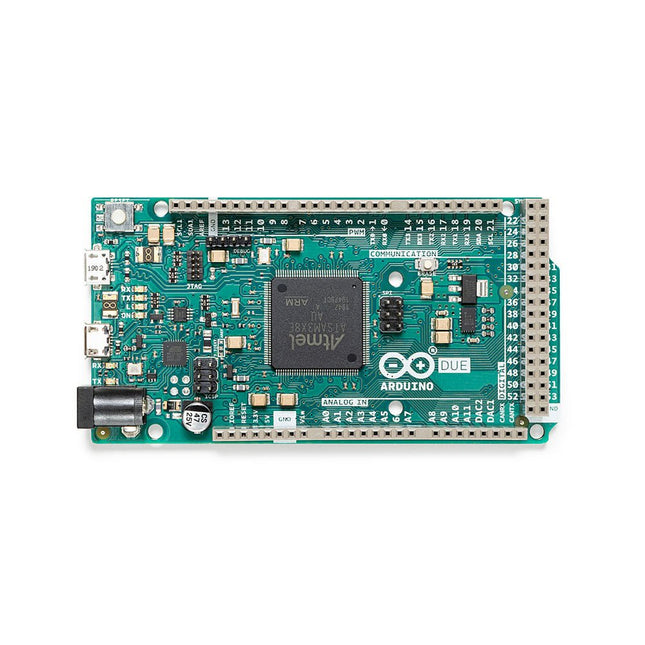
Arduino Arduino Due met headers
Het board bevat alles wat nodig is om de microcontroller te ondersteunen; sluit hem eenvoudig aan op een computer met een micro-USB-kabel of gebruik een AC / DC-adapter of batterij om aan de slag te gaan. De Due is compatibel met alle Arduino-shields die werken op 3,3V en voldoen aan de 1.0 Arduino-pinout. De Due volgt de 1.0 pinout: TWI: SDA- en SCL-pinnen die zich in de buurt van de AREF-pin bevinden. IOREF: zorgt ervoor dat een aangesloten shield met de juiste configuratie kan worden aangepast aan de spanning die door het board wordt geleverd. Dit maakt shield-compatibiliteit mogelijk met een 3,3V-board zoals de Due- en AVR-gebaseerde kaarten die op 5V werken. Een niet-verbonden pin, gereserveerd voor toekomstig gebruik. Specificaties Werkspanning 3,3 V Ingangsspanning 7-12 V Digitale I/O 54 Analoge ingangspennen 12 Analoge uitgangspinnen 2 (DAC) Totale DC-uitgangsstroom op alle I/O-lijnen 130 mA DC uitgangsstroom per I/O-pin 20 mA DC uitgangsstroom voor 3,3 V-pin 800 mA DC uitgangsstroom voor 5 V-pin 800 mA Flash-Memory 512 KB geheel beschikbaar voor de gebruikerstoepassingen SRAM 96 KB Kloksnelheid 84 MHz Lengte 101,52 mm Breedte 53,3 mm Gewicht 36 g Opmerking: In tegenstelling tot de meeste Arduino-boards, werkt het Arduino Due-board op 3,3 V. De maximale spanning die de I/O-pinnen kunnen tolereren is 3,3V. Bij het toepassen van spanningen hoger dan 3,3 V op een I/O-pin kan het board beschadigen.
€ 44,95
Leden € 40,46











